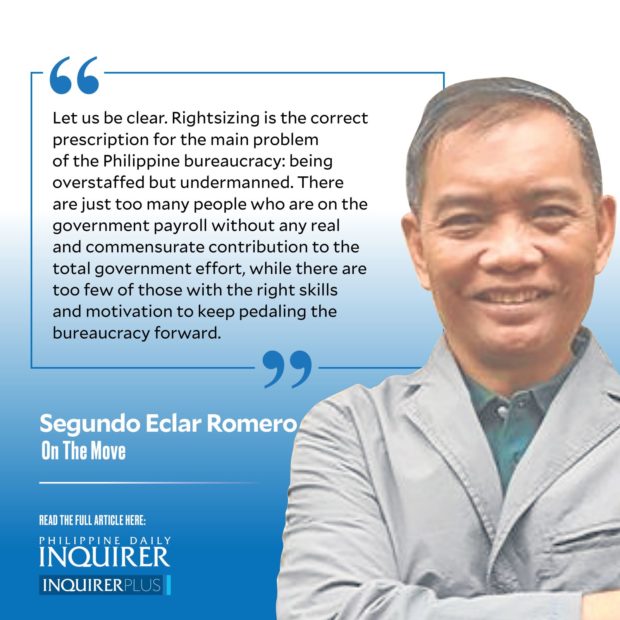Bite-sized rightsizing
Pronouncements from various government pulpits of “rightsizing” are spooking the bureaucracy. The context of this disruptive initiative—post-pandemic and pre-food and energy crises—is distressing.
Add to this the decades of profligacy that turned the lofty provisions of the 1987 Constitution into mandates for corruption, cronyism, and bacchanalian excess. The government, an amalgam of political dynasties buttressed by mercenary governing elites, is now talking about rightsizing.
But where is the spirit of rightsizing when those who would inflict it on the bureaucracy by law would appoint as many as 30 deputy speakers in the House of Representatives as a mechanism for distributing spoils? Or how about the runaway bloat in the sectoral representation system for electing party list representatives which have become a backdoor for unelectable elites?
Let us be clear. Rightsizing is the correct prescription for the main problem of the Philippine bureaucracy: being overstaffed but undermanned. There are just too many people who are on the government payroll without any real and commensurate contribution to the total government effort, while there are too few of those with the right skills and motivation to keep pedaling the bureaucracy forward.
But the strategy, timing, and approach of the unfolding extemporaneous rightsizing initiative are counterproductive. This gargantuan bureaucracy will now go on a crash diet to correct its weight and form imbalance. Sure, the head is swollen, the torso is bloated, and the legs are spindly. What magic body sculpting method will work in as short a time to leave enough time for the business of government?
Drumbeating the rightsizing initiative should have come after the overall strategy of the Marcos Jr. administration has been crafted; the systems for setting, assigning, and measuring performance targets up and down the bureaucracy are settled for all incumbents; and the structural framework for the complex machinery of government firmed up.
Agencies like the Civil Service Commission, the Department of Labor and Employment, the Department of the Interior and Local Government, and the Office of the President should have long been ready with their own function-specific completed staff work. They appear flatfooted, unable to give definitive rightsizing features and modalities, considering that this rightsizing plan has several versions in the House (Nograles) and the Senate (Pangilinan, Sotto).
For good measure, there should first be a whole-of-government reorganization commission (akin to the Villafuerte Commission during the 1986 revolutionary government period) to do the groundwork. That work should eventually enlarge and update the de facto manual of the Philippine government, the Revised Administrative Code of 1987.
Rightsizing must be guided by a theory of change. The focus should be on the whole government where the general diagnosis and prescriptions should be made and implemented at the unit level where decisions on abolition, merging, and creation of units and the reassignment, redeployment, and separation of staff should be taken. Without the guiding principles and guide rails for implementation, the spindly legs, not the torso nor the bloated head will likely be rightsized.
Human and information and communication technology interoperability will be key in rightsizing. Clearly, more of the lower-level government functionaries will be rightsized, as the application of rightsizing to the upper management levels requires more time, prototyping, proficiency, and calibration. In other words, those who are poor, vulnerable, disadvantaged, and “padrino”-less.
The Marcos Jr. administration has just begun what Bruce Tuckman calls the five stages of the psychological development of a team, which are Forming (establishing relationships), Storming (turf wars), Norming (trust-building), Performing (establishment of systems for achieving goals), and Adjourning (closure and turnover). No sooner has this government started the Forming process than it opened up an open-ended Storming phase as well.
Rightsizing is a spooky word, depending on where you sit or stand. Nothing can be more disruptive to the business of governance. It is the functional equivalent of Gotabaya Rajapaksa of Sri Lanka, naively thrusting his country into needless ruin by precipitously shifting from chemical to organic farming, not in stages, but all at once.
Now we know why the ambiguous call for “unity” did not create the critical foundational consensus through the May 9 elections on how the nation should move forward. The Marcos Jr. administration and the Filipino people will grate on one another with unpleasant surprises. Many senior technical people in government, despite their long service and experience, will still find it surprising how changeless the hidden soul of Philippine governance and administration—the “padrino” system.
doyromero@gmail.com





















